The Alfa 147 GTA shared a lot with the 156 GTA (engine, suspension elements...) but it also had important differences, not only in obvious aspects (shorter and more agile car), but also in equipment, as it now had stability control, not available in the sedan.
The 147 GTA was born in 2003, in a golden age for compact sports cars (the GTIs of a lifetime). After a bland decade where manufacturers had fallen down in their proposals, with underpowered cars more focused on versatility than radicality, those first years of the new century served for a series of monsters to be born almost at the same time. The Golf V R, the Focus RS or the Leon Cupra R were some of the most revered of the time.
Alfa then launched this car to give a punch on the table with what, in the end, would be the last incarnation of its legendary V6 "Busso" engine, coupled only to the front wheels, which had to work with 250 hp and 300 Nm of torque with no help other than traction control.
Sound, aesthetics and performance promised a lot, and as I'm going to tell you, the car responded to what you expected from it.
Aesthetics
Aesthetics are always a complicated field to talk about, as they are so subjective... In any case, the 147 is remembered by most people as one of the best compact cars in recent history.
Its lines greatly influenced the cars that have come after it for many other brands. The 147 played Italian, prioritizing design over other aspects such as versatility (we'll talk about that below). The eye appreciated it.
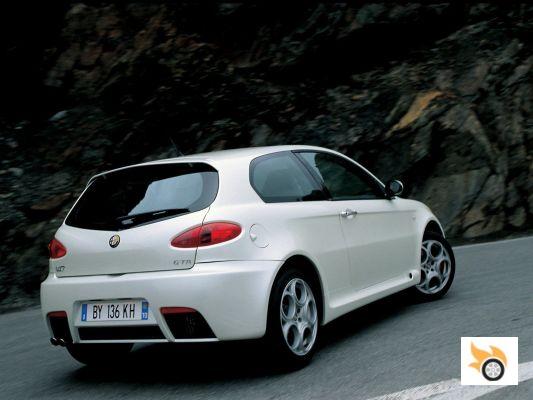
Aesthetically it is already an icon of the best compact cars ever created.
vAnd if the "conventional" 147 already looked dynamic, the GTA was a real winner if you're into badass cars. The front end was given two extra cooling intakes to allow the V6 Busso to work. The wings were muscled to allow more track width, which at the same time created a "fatter" styling, topped off at the rear with a specific bumper. The side skirts, rims and reduced height to the ground finished complementing a car that, without being extreme to the Focus RS MK2, yes that differed as much as necessary from the variants "vulgar" when it comes to thrill us.
And it did it all without a rear wing of epic dimensions. The fact is that when you look at a Giulietta Quadrifoglio now and compare it to the 147 GTA, you can't help but think that the current car has too much volume and lacks "more feminine", more curved and delicate shapes. The legislative battle for pedestrian protection, safety needs in case of impact and the urgency to provide the car with more interior space have ruined the great shape that the GTA could have had.
Cabin
To open the door of the GTA was to find great front seats. If you sit in one you'll see how well they grip your body, are comfortable (they're not overly hard like a Recaro bucket seat in a Clio RS), and allow you a comfortable and natural driving position.
The dashboard was (and is) well made in terms of materials and fit, and doesn't have a tendency to deteriorate and creak excessively. The dashboard and overall design is "typical Alfa Romeo", with independent clocks and an imposing speedometer that shows... 300 km/h of maximum speed, yes.
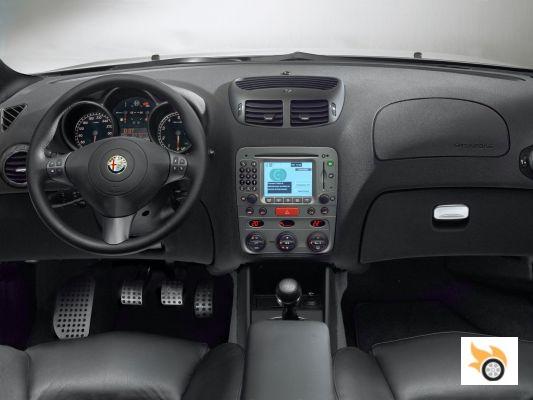
The front seats are spacious for all sizes. Forward visibility is good, although the rear three-quarter is somewhat compromised by the C-pillar and the shape of the rear window. The car's problem, in terms of versatility, lies elsewhere.
The rear seats are just enough for two adults in terms of legroom and headroom (if you put a normal-sized adult in the middle seat it will hate you), but it's the boot that's the big drawback of the 147 when compared to its rivals. It's not big enough (only 280 litres, less than a current Clio), and on top of that its shapes aren't very usable.
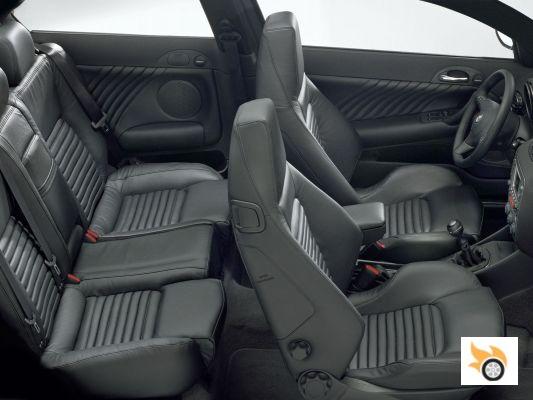
The trunk is scarce and the space in the rear seats is not generous either.
This was one of the drawbacks that cost Alfa Romeo some sales, as its contemporaries offered more space and with more regular shapes.
Trying to fit a baby stroller in the trunk is not impossible (in fact, I'll tell you that it fits in the Abarth 500...), but it's not as easy as in a current compact where it fits without removing wheels or playing Tetris. So, yes, that one drawback it had in terms of space and boot shape (sacrificing a short rear overhang and an ass-flattering design), is still present in 2014, maximized by the comparisons one sees now: B-segment utilitarian cars already beat it in this aspect...
At the time, the GTA was offered with a very advanced infotainment system for the time, with a screen that could be color, with navigation. As is often the case, these things age at lightning speed, and the idea of having to use a SIM to use the phone from the system, or view the map format will tickle your fancy. It happens with almost every car of the era, but if you have the sat nav, it can always help you when you get lost while visiting an unfamiliar European city...
Technique
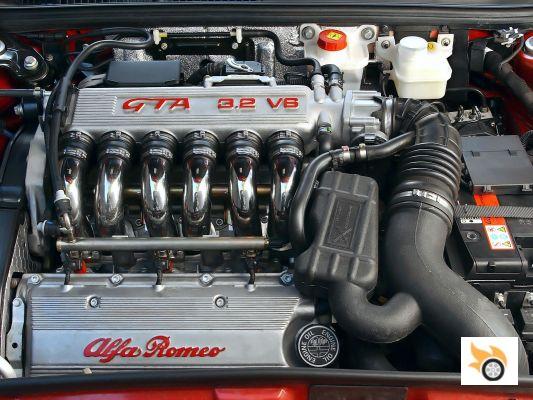
The V6 Busso is the main protagonist of this car.
Although GTA stands for "Gran Turismo Alleggerita", it's not really that the 147 GTA is "a lightweight". Its main claim and attribute is its V6 Busso. And believe me, the engine alone is enough of an excuse to buy this car.
The Busso here has 3.2 litres of displacement and 24 valves. There's no room for variable valve timing, but it puts out 250 hp at 6,200 revs and 300 Nm at 4,800 revs. The special thing is that it is capable of stretching beyond those 6,200 revs (almost up to 7,000) and also offers a large part of the torque from just beyond 2,000 revs, so the band of use is wider than those two maximum figures seem to indicate.
Up front, the 147 GTA has double overlapping triangles suspension (go look for that in a compact car these days...), while at the rear it makes use of an independent McPherson strut equivalent.
To transfer the power to the tarmac it relies on just the two front drive wheels, to which the torque comes through a perfectly tuned six-speed gearbox (you reach top speed in sixth almost to the cut, 246 per hour), and you can opt for a manual system, or a Selespeed gearbox, which we will also talk about below, and which is a sequential operator of the same manual gearbox.
1,435 kilos doesn't make it, as I said above, particularly light. When it was launched, there were 305-millimetre brake discs on the front axle bitten by rigid four-piston Brembo calipers. Soon after, these discs were replaced by 330-millimetre discs that were better able to withstand the heat.
Dynamics
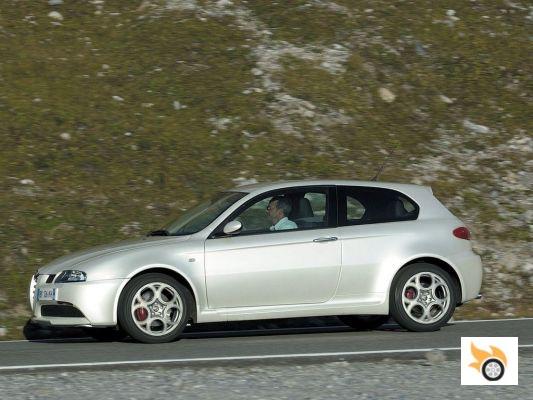
Driving a 147 GTA is a real event, unlike almost anything else you can find in today's dealerships. You open the door, slide into the seat and when you execute the starter, the purr of the V6 already defines the whole experience. No engine sounds quite like it. Even the best digital synthesizer you hear today won't come close.
Even the Golf's R32 vocals fall short when compared to the Busso.
Once the positive sound impression is over, starting to drive it is to encounter the typical Alfa Romeo feel: very direct steering, but poor turning radius when it's time to park or drive down the street. The suspension, being sporty, is not uncomfortable in urban potholes. The engine response, pushing from very low, makes it pleasant to use. The problem is if you pay attention to the fuel consumption: 20 litres in city driving is something that can happen...
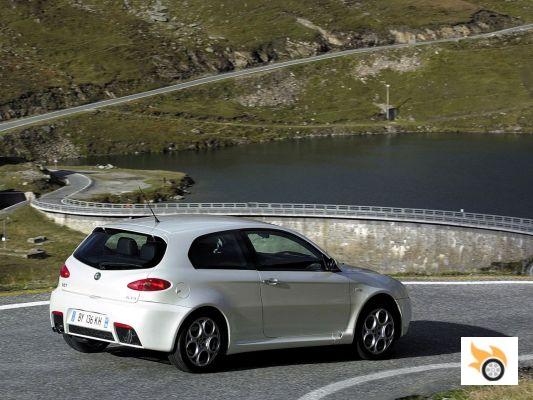
The tone of the V6 and the amount of sensations that reach your senses dominate an unforgettable experience.
If you go out on a motorway or open national road in search of a long trip, you'll find yourself with a "long-legged" car, one of those that has no trouble covering long distances at a high or illegal pace. Torque and power are easy to feel and there are no turbocharged "holes". If the tarmac is good, the car is comfortable and consistent. If there are curls in the asphalt, the damping is a bit bouncy.
Here the fuel consumption can go down, it depends on your speed. You can average between seven and nine litres of fuel in relaxed driving, or go up to 12 litres if you like to push it a bit more. Here air conditioning, sound system (the optional Bose is a marvel) and sound insulation will play in favor of the passengers in the front seats, who will enjoy a real GT.
But what's really interesting is to go on the road, isn't it? If we start with a fast mountain pass, we will find a car very interested in entering the curves at the slightest hint, with a front axle that bites early and well. Although there's a lot of weight on the front axle and the engine hangs a bit in front, the time it takes you to lean out straight (you know, related to the now famous polar moment of inertia) is low. There's a bit more lean than you might expect, but it's a necessary toll to keep the car from being "go-getter" and following ruts and bumps with the steering on the straight sections.
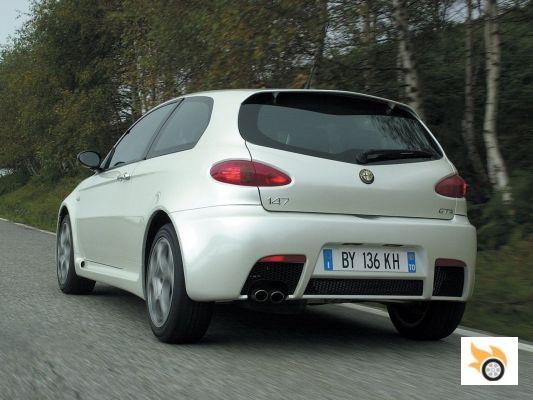
Once supported, the car bites the apex of the corner easily, although if we go too far in our prediction of corner entry speed, we will have a considerable front drag. Trying to play with the inertias to unsettle the rear or playing with the brake on support to yaw the car doesn't work: the stability control is there to put things in place.
When it's time to exit the corner, we can give gas without too much fear of losing the front end. Thanks to having an old-school naturally aspirated engine, we can modulate precisely how much torque we send to the wheels, something that is no longer in use, and will help us to avoid wasting time burning the inside tyre for no apparent reason. On dry tarmac there is, therefore, more than enough traction. In the wet we can saturate the system a bit and end up with the traction and stability controls in action. Below, in the proposed modifications section, we explain a solution for all this, in any case.
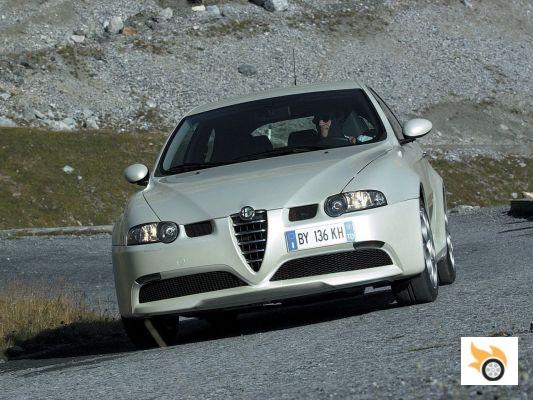
If the pass gets more complicated and the curves get tighter and tighter, the gearbox will convince us, as it is not too long. The set of pedals to make the heel toe is well achieved. At the end of the day, only the fact that you can't yaw much from the back can be a drawback. But it turns out that the car is so positive in its front end and so agile without getting out of place (it changes support very well, even if it tilts quite a lot), it makes you smile.
Of course, if the asphalt starts to break up, the 147 GTA chokes a bit. The damping suffers there, and in high-frequency movements it loses its rhythm, allowing the spring to get a bit out of control, giving us bounces that, although they don't affect stability, they do affect traction and comfort.
The brakes, to all this, are very powerful. The original 305 millimetre discs get hot too soon if you go on the attack. Those that were mounted later, larger, better withstand the attacks that you offer with almost a ton and a half that you drive. The steering is another gem. I told you above that it's very direct, but it also "talks to you", it tells you how much grip there is under the wheels. The 147 GTA is one of those old-school cars that speaks to you through your senses. It makes you feel the road and that's what makes you fall in love with it.
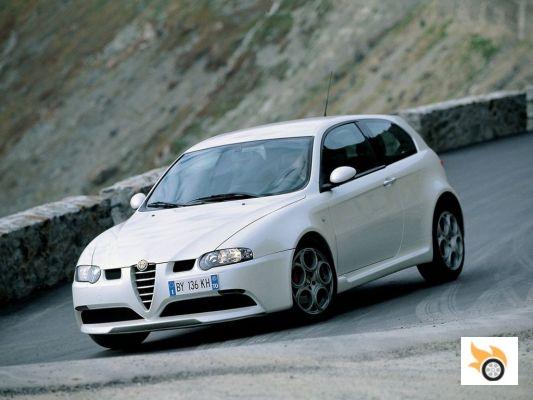
Perhaps his main problem is his seemingly insatiable thirst for petrol.
Driving for fun, reaching an average fuel consumption of 22 or 25 litres is not impossible, and that reminds you once again that this is not a car to be driven in a tight gas station.
If we come to the awkward question of whether to opt for a manual or a sequential gearbox, my tester's arse, peeled in a thousand battles and too modernised, will tell you to go for the manual. It offers a purer ride, where you can play with the toe-tap. The sequential was quite a milestone at the time, but it's a gearbox that's a long way from being on par with the sequentials of 2014. If we obviate where we've come to today, I'll tell you that the Selespeed at least is acceptable in its response times (better than the one employed in the Abarth 500 that I've criticized so much). The problem is that the Selespeed means we have more things on our hands that can go wrong, and cars with problems in the automated clutch system are not uncommon.
What to change
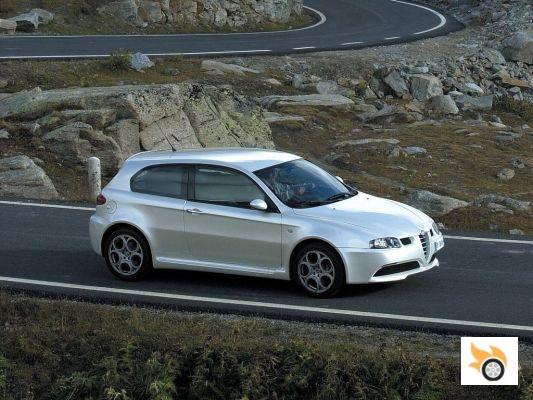
An exhaust, Bilstein suspension and a Q2 locking differential, and the GTA will rip your heart out.
The good thing about the 147 GTA is that it's a car of passions that also offers possibilities to improve some of its qualities with some investment. If you love the sound of the V6, listening to it enhanced by an exhaust like the Ragazzon (brand that we carry in the Abarth of the long duration test) will leave you stunned, although it may be a little loud if you use the car daily in the city.
Alfa Romeo briefly offered the Q2 self-locking differential on the 147, as you may recall, but never offered it on the GTA. The thing is, that Q2 locking differential fits in the GTA's casing, and it exponentially improves the car's traction when you're pushing it out of corners. It also eliminates some of the understeer on corner entry and gives you more steering action. The problem? Maybe it becomes a bit more critical in its behaviour, but the stability control is still there to dominate the machine, so I don't see a problem with it.
The suspension can also be modified. The Bilstein B12, B14 and B16 suspensions are excellent options to better control body movements. If you're a radical of mine, the B16 would be your best choice, but the B12 offers better compromise for everything. Either one instantly eliminates uncontrolled bouncing by having better damping capability relative to the spring.
What to check
As with the 156 GTA, I have a good list of things to check that can go wrong with these cars. From other models we do not have so many references, and maybe this makes this list a little more complete, but it is not a problematic car when compared to others of similar power and age. Here we go:
- Distribution: The Busso requires preventive belt changes if we want to avoid unfortunate problems. We are talking about changing the belt every three years or about 65,000 kilometers. Yes, there will be people who will tell you that it is not necessary to do it so often, until the disaster happens... It is better to be safe here. The water pump should be changed with every timing change (as in all cars, even if your mechanic tells you otherwise).
The standard water pump had plastic blades that break over time, it is better to fit a metal one, available from Alfa Romeo spare parts. In the official workshop they will know how to make the change without problems. The belt tensioner is also often a problem, as we mentioned in the 156. If you change the belt every three years or 60,000 km, the tensioner problem should not exist.
Check and certify that the seller gives you real data of when he changed the distribution.
- Rear main cylinder head gasket: Of the two main cylinder heads of this "uve" engine, there is data of burnt cylinder head gaskets on the rear main cylinder head after 160,000 km. So be careful with these mileages in these engines.
- Flowmeter: It tends to burn, and the engine does not work "fine". It usually dies at 100,000 kilometers on average, although it is not expensive to replace (in fact, it is the same flowmeter that Opel uses in the Agila!) If the engine idles unsteadily or jerks, the problem may be there.
- Water radiator: The original radiator is made of steel, and tends to rust over time, especially if the car sleeps outside or lives near the sea. There are aluminum radiators that avoid this problem. If the car leaks coolant or overheats, the problem may be there.
- Gearbox: Gearbox failures are becoming more common than usual. Open conventional differential breaks create punctures in the gearbox housing and end in disaster. Replacing the standard differential with a Q2 is a good idea to solve both problems. Properly checking that all gears engage correctly, especially 4th gear, is vital to avoid buying a car that is too well-worn. Clutches last 100,000 kilometres on manual units if the driver doesn't make them slip excessively.
- Suspension: Suspension bushes, especially in the front arms, tend to deteriorate with use. The problem is that the bushings can't be replaced without replacing the entire arm. Once they fail, the steering becomes inaccurate.
- Bonnet locking system: It tends to stick and not close properly. Check to make sure the unit you're looking at has it right. If not, it's not something extremely complicated to fix either. The "postrestyling" 147's have a plastic latch that works better and can be fitted to the GTA.
- Brakes: If you have a choice, look for a car with 330 millimeter discs and radial calipers (I mentioned above that it was standard equipment shortly after the car came out), as they resist heat much better.
- Wheels: The optional 18-inchers offer more precise lines and more feedback on the steering wheel, though they're less friendly to small bumps.
How much to pay
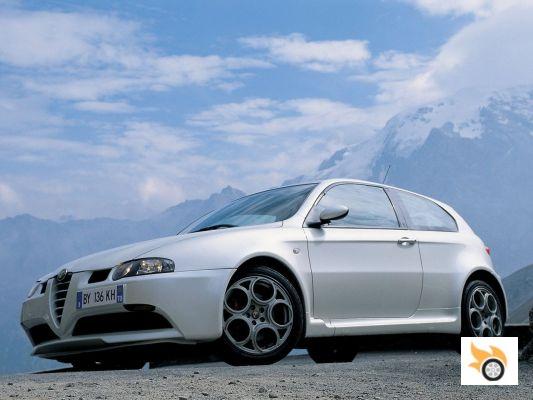
Here's the big issue. As they are very powerful cars that tend to be driven without contemplation, there are cars in very different states.
In any case, paying between 7,500 and 10,000 euros should be "the norm". A good price for a great car, with a mythical engine. Just remember that you'll be spending a lot of money on petrol!
Report originally published in November 2014, recovered for Pistonudos.
























